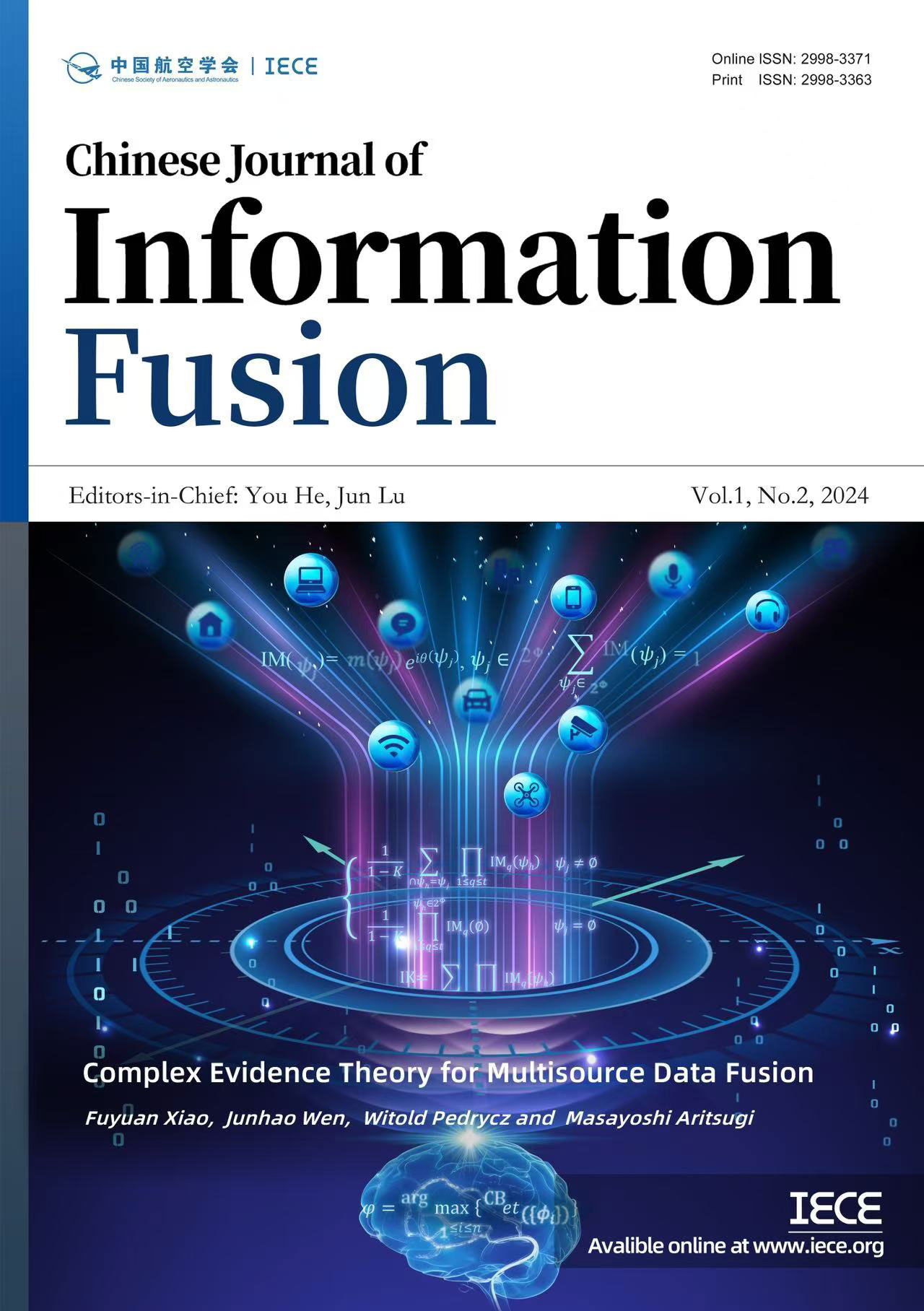Chinese Journal of Information Fusion
ISSN: 2998-3371 (Online) | ISSN: 2998-3363 (Print)
Email: [email protected]


 Submit Manuscript
Edit a Special Issue
Submit Manuscript
Edit a Special Issue

[1] Sepulveda, E., & Smith, H. (2017). Technology challenges of stealth unmanned combat aerial vehicles. The Aeronautical Journal, 121(1243), 1261-1295.
[2] Qin, J., & Wu, X. (2016, October). Modeling and simulation on the earliest launch time of ship-to-air missile of warship formation in cooperative air-defense. In 2016 IEEE Advanced Information Management, Communicates, Electronic and Automation Control Conference (IMCEC) (pp. 375-379). IEEE.
[3] Gao, Y., Li, D. S., & Zhong, H. (2020). A novel target threat assessment method based on three-way decisions under intuitionistic fuzzy multi-attribute decision making environment. Engineering Applications of Artificial Intelligence, 87, 103276.
[4] Zhang, R., Chai, R., Chai, S., Xia, Y., & Tsourdos, A. (2023). Design and practical implementation of a high efficiency two-layer trajectory planning method for AGV. IEEE transactions on industrial electronics, 71(2), 1811-1822.
[5] Bashir, N., Boudjit, S., Dauphin, G., & Zeadally, S. (2023). An obstacle avoidance approach for UAV path planning. Simulation modelling practice and theory, 129, 102815.
[6] Ren, Z., Rathinam, S., Likhachev, M., & Choset, H. (2022). Multi-objective path-based D* lite. IEEE Robotics and Automation Letters, 7(2), 3318-3325.
[7] Chong, L., Jian, L., & XueQuan, L. (2020). Static rectangle expansion A* algorithm for pathfinding. IEEE Transactions on Games, 14(1), 23-35.
[8] Ali, H., Xiong, G., Haider, M. H., Tamir, T. S., Dong, X., & Shen, Z. (2023). Feature selection-based decision model for UAV path planning on rough terrains. Expert Systems with Applications, 232, 120713.
[9] Diao, Q., Zhang, J., Liu, M., & Yang, J. (2023). A Disaster Relief UAV Path Planning Based on APF-IRRT* Fusion Algorithm. Drones, 7(5), 323.
[10] Zhang, J., An, Y., Cao, J., Ouyang, S., & Wang, L. (2023). UAV trajectory planning for complex open storage environments based on an improved RRT algorithm. IEEE Access, 11, 23189-23204.
[11] Hao, G., Lv, Q., Huang, Z., Zhao, H., & Chen, W. (2023). Uav path planning based on improved artificial potential field method. Aerospace, 10(6), 562.
[12] Liu, J., Yan, Y., Yang, Y., & Li, J. (2024). An Improved Artificial Potential Field UAV Path Planning Algorithm Guided by RRT Under Environment-aware Modeling: Theory and Simulation. IEEE Access.
[13] Wu, J., Wang, H., Wang, Y., & Liu, Y. (2021). UAV reactive interfered fluid path planning. Acta Automatica Sinica, 47(1), 1-16.
[14] Yang, T., Yang, F., & Li, D. (2024). A New Autonomous Method of Drone Path Planning Based on Multiple Strategies for Avoiding Obstacles with High Speed and High Density. Drones, 8(5), 205.
[15] Dewangan, R. K., Shukla, A., & Godfrey, W. W. (2019). Three dimensional path planning using Grey wolf optimizer for UAVs. Applied Intelligence, 49, 2201-2217.
[16] Hu, K., & Mo, Y. (2024). A novel unmanned aerial vehicle path planning approach: sand cat optimization algorithm incorporating learned behaviour. Measurement Science and Technology, 35(4), 046203.
[17] Zheng, R. Z., Zhang, Y., & Yang, K. (2022). A transfer learning-based particle swarm optimization algorithm for travelling salesman problem. Journal of Computational Design and Engineering, 9(3), 933-948.
[18] Xue, J., & Shen, B. (2023). Dung beetle optimizer: A new meta-heuristic algorithm for global optimization. The Journal of Supercomputing, 79(7), 7305-7336.
[19] Miao, C., Chen, G., Yan, C., & Wu, Y. (2021). Path planning optimization of indoor mobile robot based on adaptive ant colony algorithm. Computers & Industrial Engineering, 156, 107230.
[20] Shen, Q., Zhang, D., Xie, M., & He, Q. (2023). Multi-strategy enhanced dung beetle optimizer and its application in three-dimensional UAV path planning. Symmetry, 15(7), 1432.
[21] Lyu, L., Jiang, H., & Yang, F. (2024). Improved Dung Beetle Optimizer Algorithm with Multi-Strategy for global optimization and UAV 3D path planning. IEEE Access.
[22] Jiachen, H., & Li-hui, F. (2024). Robot path planning based on improved dung beetle optimizer algorithm. Journal of the Brazilian Society of Mechanical Sciences and Engineering, 46(4), 235.
[23] Wai, R. J., & Prasetia, A. S. (2019). Adaptive neural network control and optimal path planning of UAV surveillance system with energy consumption prediction. IEEE Access, 7, 126137-126153.
[24] Liu, Y., Zheng, Z., Qin, F., Zhang, X., & Yao, H. (2022). A residual convolutional neural network based approach for real-time path planning. Knowledge-Based Systems, 242, 108400.
[25] Luo, X., Wang, Q., Gong, H., & Tang, C. (2024). UAV path planning based on the average TD3 algorithm with prioritized experience replay. IEEE Access.
[26] Zhou, C., Gu, S., Wen, Y., Du, Z., Xiao, C., Huang, L., & Zhu, M. (2020). The review unmanned surface vehicle path planning: Based on multi-modality constraint. Ocean Engineering, 200, 107043.
[27] Huang, Z. M., Chen, W. N., Li, Q., Luo, X. N., Yuan, H. Q., & Zhang, J. (2020). Ant colony evacuation planner: An ant colony system with incremental flow assignment for multipath crowd evacuation. IEEE Transactions on Cybernetics, 51(11), 5559-5572.
[28] Yang, T., Yang, F., & Li, D. (2022). An Air Target Course Prediction Method Based on Sub-Regions Divide and Conquer With Double Variable Weight. IEEE Access, 10, 117871-117885.
Chinese Journal of Information Fusion
ISSN: 2998-3371 (Online) | ISSN: 2998-3363 (Print)
Email: [email protected]

Portico
All published articles are preserved here permanently:
https://www.portico.org/publishers/iece/